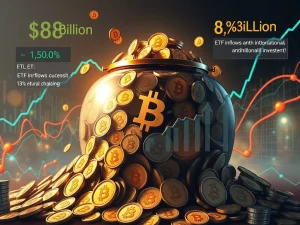Northern Mariana Islands Stablecoin Bill Gets Crucial Second Chance

The path for a Stablecoin Bill in the Northern Mariana Islands has taken a significant turn. Lawmakers in the US Pacific territory are giving the legislation a crucial second chance after overcoming a key hurdle. This development is particularly noteworthy as the small island of Tinian seeks to potentially launch the first US Stablecoin issued by a public entity, positioning itself in a unique race against states like Wyoming.
Northern Mariana Islands Senate Overrides Veto
The Stablecoin Bill, which includes provisions for internet casino licenses and the issuance of a ‘Tinian Stable Token,’ faced a setback when Governor Arnold Palacios vetoed it in April. However, the Senate for the Northern Mariana Islands recently voted 7-1 to override the governor’s decision. This strong show of support pushes the bill forward despite initial executive resistance.
The bill now heads to the 20-member House of Representatives. To become law, the House must also achieve a two-thirds majority vote to override the governor’s veto. If successful, this could pave the way for the Tinian government, part of the Commonwealth of the Northern Mariana Islands, to move forward with its stablecoin plans.
What is the Tinian Stablecoin Plan?
The proposed stablecoin, known as the Marianas US Dollar (MUSD), is intended to be a fully backed US Stablecoin. Key details include:
- **Backing:** MUSD would be backed by cash and US Treasury bills held in reserve by the Tinian Municipal Treasury.
- **Issuer:** The Tinian local government would manage and redeem the token through licenses issued under the bill.
- **Technology:** Marianas Rai Corporation, a local tech firm, is selected as the exclusive infrastructure provider.
- **Blockchain:** MUSD is planned to be built on the eCash blockchain, a fork of Bitcoin Cash.
This Tinian Stablecoin initiative is part of a broader effort to diversify the island’s economy, which heavily relies on tourism and faced hardship during the COVID-19 pandemic.
Arguments For and Against the Initiative
The Stablecoin Bill and the Tinian Stablecoin proposal have generated debate:
Arguments from proponents, like Senator Karl King-Nabors:
- Provides a stringent way to oversee online gaming.
- Allows for more transparency through software tracking.
- Aligns with needed economic diversification measures.
- Offers a potential revenue source without requiring physical infrastructure.
Concerns raised by opponents, like Governor Palacios and Senator Celina Babauta:
- Potential legal issues and questions of constitutionality.
- Lack of resources and manpower for enforcement.
- Challenges in restricting the regulated activity solely to Tinian.
- Need to comply with federal statutes, which could pose difficulties for local Crypto Regulation.
The Bigger Picture: US Stablecoin Race and Crypto Regulation
Tinian’s effort places it in a race with states like Wyoming, which is also working towards issuing a US Stablecoin. This local-level push for a public stablecoin occurs within the larger context of ongoing, and often stalled, efforts at the US federal level to establish clear Crypto Regulation, specifically for stablecoins.
Bills like the GENIUS Act and the STABLE Act in the US Congress have faced political hurdles, highlighting the complexity of creating a unified federal framework for stablecoins. The progress, or lack thereof, at the federal level makes initiatives like Tinian’s particularly interesting as potential test cases for how US Stablecoins might be implemented and regulated by different governmental bodies.
Conclusion: What’s Next for the Tinian Stablecoin?
The override of the governor’s veto by the Northern Mariana Islands Senate gives the Stablecoin Bill a significant boost. The focus now shifts to the House of Representatives, where the bill’s fate will be decided. A successful House vote would not only pass the bill into law but also position Tinian as a potential pioneer in the realm of publicly issued US Stablecoins, adding a unique chapter to the evolving landscape of Crypto Regulation in the United States.









